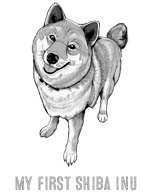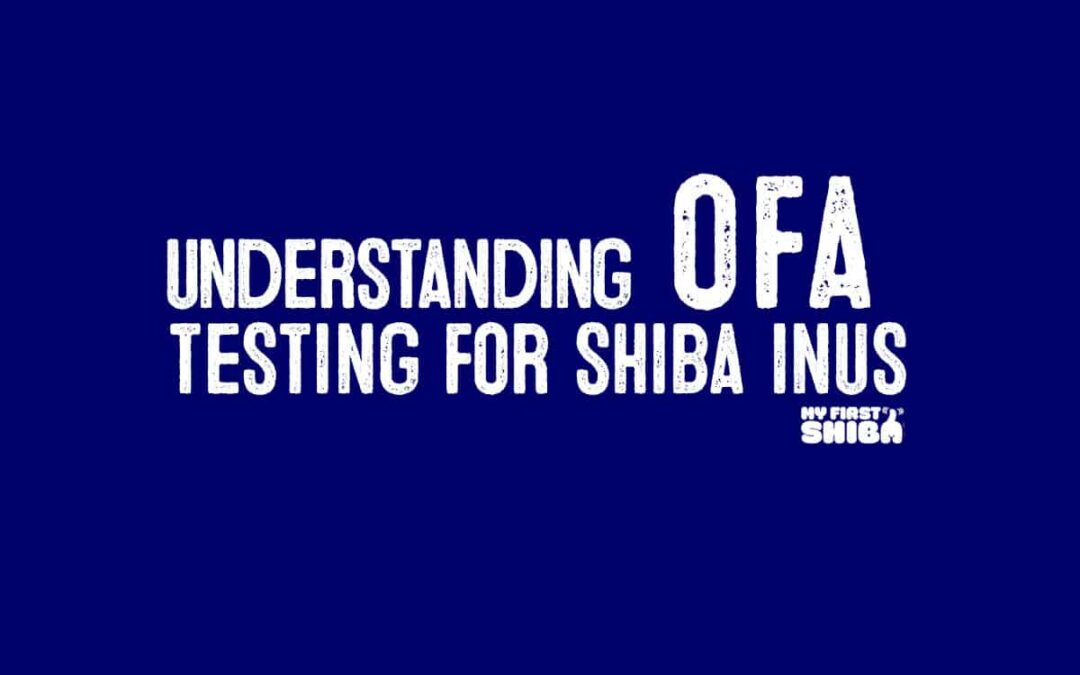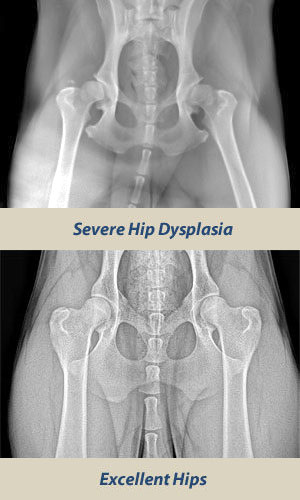On occasion, our posts contain affiliate links. However, we only recommend products that we truly believe in. For more information, visit my privacy policy page.
Phew, this website is a labor of love and largely a one-woman show so unless indicated, all articles written by J.Tsukamoto
If you are planning on bringing home a Shiba Inu puppy - YOU MUST make sure that the breeder has OFA tested both of the parent dogs.
Why?
Because one, if the breeder did not - you should avoid the breeder, period. Not health screening mating dogs is dead giveaway for inexperienced or low-quality breeders.
Two, because getting a puppy from a breeder that does OFA testing means you'll be much more likely to get a puppy that avoids the misery of being struck with health issues later in life.
Patellar luxation is a particularly devasting disease that affects Shiba Inus. The severity ranges from mild to so severe that surgical intervention is the only solution.
Screening for this disease along with hip dysplasia and eye disease is a must for any Shiba Inu that breeds.
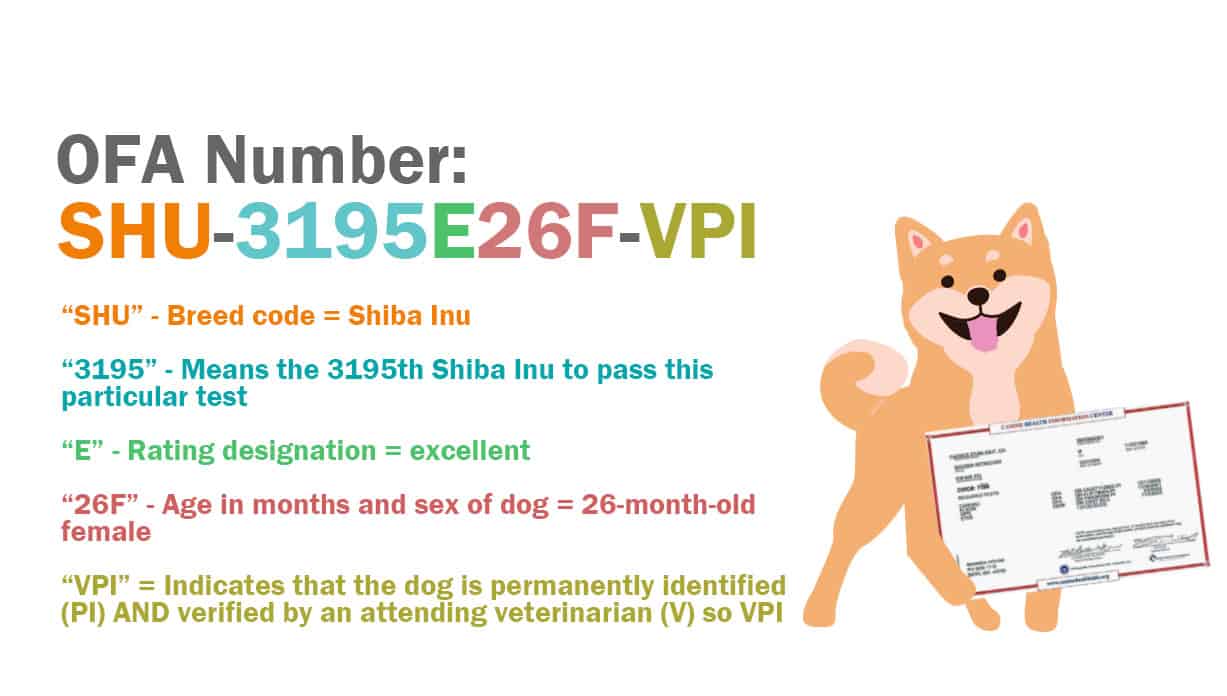
Explanation of OFA test - find more details on the abbreviations towards the end of the article...
Who is the OFA?
OFA stands for The Orthopedic Foundation for Animals. The OFA basically keeps a database of radiographs (x-rays) and genetic tests to aid breeders in producing healthy puppies with lower risks of genetic disease.
The OFA was founded in 1966, mostly attributed to John M. Olin who wanted to improve the hip health of his Golden Retrievers.
Mr. Olin was a regarded inventor, conservationist, and field trial participant.
Together with the help of veterinarians, The Golden Retriever Club of America, and the German Shepherd Dog Club of America, Mr. Olin facilitated the formation and incorporation of the OFA.
While OFA initially focused on hip dysplasia, the OFA has since expanded into many other inherited diseases as well as other companion animals.
The mission of the OFA is “To improve the health and well-being of companion animals through a reduction in the incidence of genetic disease,”
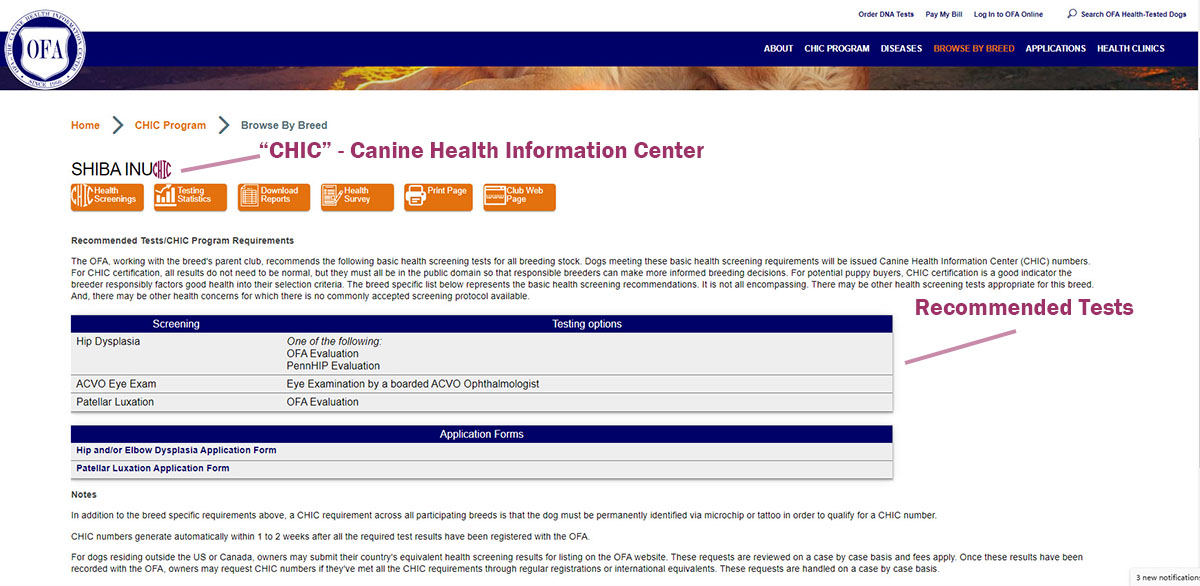
What Does The OFA Do?
The OFA helps dog breeders, veterinarians, and prospective dog owners to use their resources to evaluate a dog’s pedigree, health strengths, and health weaknesses.
By gathering and storing the data of health tests, the OFA can continue to improve the health of companion animals by recognizing diseases and helping breeders to make informed breeding decisions.
OFA test results also help veterinarians with treatment plans as well as inform prospective dog owners about future health predictors for their new puppy.
Early detection of genetic disease in breeding dogs and family pets can aid in early surgical intervention, treatment plans, and breeding decisions.
In addition to hip dysplasia, the OFA tests and grades:
- Hip Scoring
- Eye Testing
- Elbow Grading
- Hearing Tests
- Heart Testing
- Thyroid Testing
- DNA testing
- Various other tests
Different dog breeds have different testing recommendations based on disease risk. For Shiba Inus, the recommended OFA tests / CHIC requirements are:
Hip Dysplasia - Shiba Inus are recommended to have hip dysplasia testing. This can be done through an OFA evaluation or a PennHIP evaluation.
Eye Examination - Shiba Inus are recommended to have an eye examination done by a boarded ACVO Ophthalmologist.
Patellar Luxation - Shiba Inus are highly recommended to have a Patellar Luxation exam done via an OFA evaluation.

What Is the CHIC Certification Program?
The OFA, partnering with participating parent dog clubs, created CHIC, Canine Health Information Center, to research and maintain health information on health issues specific to specific breeds.
By working closely with parent dog clubs, CHIC has established a recommended protocol for breed-specific health tests and screenings.
To achieve CHIC Certification, the dog must be screened for every disease recommended by their parent club, as well as have the results publicly available.
The main goals of CHIC included maintaining a central system of health information that will support further research into canine disease as well as providing valuable information to breeders and dog owners.
To qualify for CHIC Certification / CHIC number, Shiba Inu owners will need to complete the above-mentioned health screenings (specific breed recommended tests) by qualified providers.
Additionally, the Shiba Inu will need a permanent form of identification via a microchip or tattoo.
It’s also a requirement that the CHIC reports are released to the public domain.
No additional fee is required for CHIC certification.
If all requirements and OFA tests are complete, CHIC numbers will generate automatically within 1 to 2 weeks.
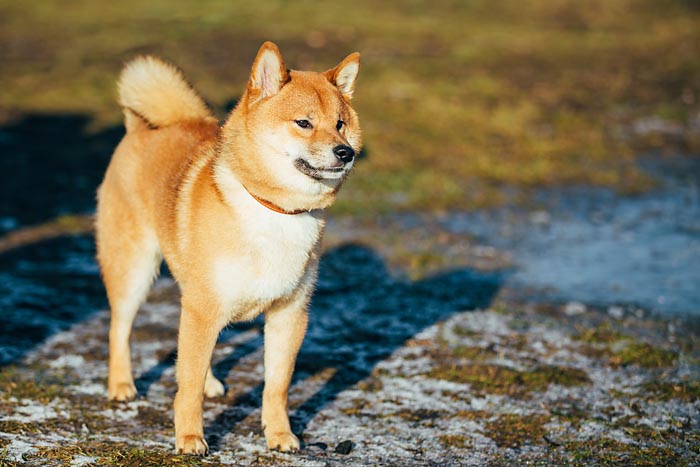
How To Get Your Shiba Inu OFA Tested / CHIC Certified
The following are directions for getting your Shiba Inu OFA tested and CHIC certified. (The three different tests do not need to be down all at once)
For an OFA Hip Dysplasia test:
- OFA certificates for Hip Dysplasia are given to dogs 24 months and older. Puppies between 4 months and 23 months can get preliminary screenings https://www.ofa.org/about/policies/preliminary-evaluations
- Make an appointment at a veterinary office that does Hip Dysplasia tests.
- Visit https://www.ofa.org/application-forms and download the PDF form to fill out.
- Fill out form with all necessary details
- Bring completed form, microchip I.D. #, AKC registration to the appointment
- If your vet will sedate the dog, no food or liquids prior to the test on day of test (check with your veterinarian for directions)
- After the test is done, the form is signed by the owner of the dog and attending veterinarian.
- Some veterinarians will submit the forms electronically to the OFA. Your vet will inform you to pay the OFA fees directly to their office or for you to directly send payment yourself.
- If you want your Shiba’s OFA results listed on their pedigree, they must be AKC registered and microchipped / tattooed.
OFA fees for 24 months older (1 dog) - $45.00
Vet fees / radiographs: varies by vet
For an OFA Patellar luxation Test
- OFA certificates for Patellar luxation are given to dogs 12 months of age or older. Evaluation of puppies under 12 months of age is encouraged if you plan on breeding early.
- Make an appointment at a veterinary office that does Patellar luxation tests.
- Visit https://www.ofa.org/application-forms and download the PDF form to fill out.
- Fill out form with all necessary details
- Bring completed form, microchip I.D. #, AKC registration to the appointment
- Patellar Luxation tests are usually done without sedation
- After the test is done, the form is signed by the owner of the dog and attending veterinarian.
- Some veterinarians will submit the forms electronically to the OFA. Your vet will inform you to pay the OFA fees directly to their office or for you to directly send payment yourself.
- If you want your Shiba’s OFA results listed on their pedigree, they must be AKC registered and microchipped / tattooed.
OFA test fee For 12 months or older (1 dog): $15
Vet Fee: Varies by vet
For an OFA Eye Examination test
- OFA eye exams can be done on puppies six weeks of age and older.
- OFA eye certifications last for one year.
- Go to https://www.acvo.org/ and find a veterinary ophthalmologist near your and make an appointment.
- Visit https://www.ofa.org/application-forms and download the PDF form to fill out.
- Fill out form with all necessary details
- Bring completed form, microchip I.D. #, AKC registration to the appointment
- After the test is done, the form is signed by the owner of the dog and the veterinarian.
- Some veterinarians will submit the forms electronically to the OFA. Your vet will inform you to pay the OFA fees directly to their office or for you to directly send payment yourself.
- If you want your Shiba’s OFA results listed on their pedigree, they must be AKC registered and microchipped / tattooed.
OFA test fee for dogs (minimum 6 weeks old): $15
Certified veterinary ophthalmologist (ACVO) fee: highly variable
Understanding OFA Scores and CHIC Certification
It’s important to understand that just because a dog is OFA tested and / or CHIC certified, that DOES NOT mean that the dog has great test results.
It just means that the dog has been properly tested following OFA protocol.
So while OFA testing is a good indicator of breeder commitment and intention - you still have to check if the dog received an OFA certificate number to indicate passing scores.
OFA testing can find dogs with very good scores along with dogs that score very poorly.
Dogs that pass OFA minimum standards will receive OFA numbers whereas dogs that don’t pass will not receive numbers.
Even with the CHIC designation - dogs that have poor scores will still be CHIC certified as long as the test results are open to the public.
The best way to interpret OFA scores is to visit the OFA website and search for the disease. Each disease will have an information page that gives details on how results are scored.
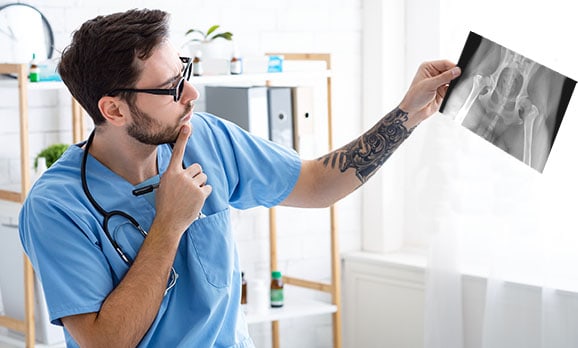
Hip Dysplasia - OFA Grading
OFA grading of hip dysplasia falls into 7 classifications : Excellent, Good, Fair (all within Normal limits), Borderline, and then Mild, Moderate, or Severe (the last three considered Dysplastic).
Excellent: Superior conformation; The femoral head is a deep-seated ball that fits tightly into a well-formed socket with minimal joint space.
Good: Slightly less than superior but a well-formed hip joint is visualized.
Fair: Minor irregularities; the hip joint is wider than a good hip. The femoral head slips slightly out of the socket. The socket may also appear slightly shallow.
Borderline: Not clear. More inconsistency than fair though there are no arthritic changes present that definitively diagnose the hip joint being dysplastic.
Mild: Significant subluxation is present where the ball is partially out of the socket causing an increased joint space. Shallow socket only covering pall partially
Moderate: The ball barely sits in a shallow socket. Secondary arthritic bone changes and various degrees of trabecular bone pattern changes.
Severe: Marked evidence that hip dysplasia exists. The ball is partly or completely out of a shallow socket. Significant arthritic bone changes present (femoral neck and head, acetabular rim).
The hip grades of excellent, good and fair are within normal limits and are given OFA numbers. All dogs with permanent identification will pass AKC requirements to have OFA test scores printed on their pedigree. Results will be in the public domain.
Borderline, mild, moderate and severely dysplastic hip grades are reviewed by a team of radiologists and a report is generated to document the abnormal test findings. OFA numbers will not be given
Dysplastic hip grades are closed to public information unless the owner has specifically allowed the information to be public.
Patellar Luxation Scoring
To receive an OFA number, Shiba Inus must have a “normal” test score and be 12 months of age and over.
Any degree of luxation ranging from 1 - 4 will not receive an OFA Number.
However, even without OFA numbers, your Shiba can still be CHIC certified so long as you complete the required tests and have the results open to the public.
The Four Grades of Patellar Luxation:
- Grade 1: A kneecap that can be luxating with manual pressure but is apart from that within the groove.
- Grade 2: The kneecap luxates spontaneously, with frequent luxation sometimes becoming permanent
- Grade 3: The kneecap is luxated permanently but can be manually replaced in the normal position
- Grade 4: The kneecap is luxated permanently and can’t be manually replaced in the normal position
Instead of making a separate visit for a patellar luxation test, ask your veterinarian(s) if they do OFA patellar luxation tests and combine the test with a scheduled vet visit to save a little on costs.
OFA Eye Examination (Previously CERF Examination)
OFA Eye examinations replaced CERF eye exams in 2014. CERF exams are still valid for CHIC certification.
CERF examination results are also still viewable on the OFA registry. They are basically almost the same exams - just a different organization managing the information.
The OFA is better equipped to conduct enhanced reporting of aggregate statistics regarding disease prevalence and progression by breed.
To receive an OFA eye certification number, your Shiba Inu must be tested by an approved veterinary ophthalmologist (a Diplomate of the American College of Veterinary Ophthalmology – ACVO) which you can search for here.
There is no age requirement and puppies with their eyes open can be tested.
The certification is valid for only 12 months at a time.
Your Shiba Inu will receive an eye certification number if he or she is found free of observable inherited eye disease.
If your Shiba Inu has observable, but passing conditions (a.k.a. Breeder codes), he or she will still receive an eye certification number but the breeder code will be viewable on the public website.
Non passing eye results will not be viewable to the public unless the dog’s owner has granted permission on the form.
OFA VS. PennHipp Exam for Hip Dysplasia
Two tests are available for OFA numbers for Hip Dysplasia - the OFA hip dysplasia exam or the PennHipp exam.
Both tests have different requirements, costs, and scoring metrics.
The PennHip test must be performed by a veterinarian and vet tech that has completed a PennHip training program. Although the program is free, not all veterinarians have the time commitment to complete the program.
The OFA test only requires the test to be conducted by a veterinarian which makes the test much easier to find.
The OFA scoring system is a 7-point qualitative system that ranges from excellent to severe.
The PennHip scoring system is a quantitative (0-1) scoring system that is based on a calculated Distraction Index (DI) with 0 being the best and 1 being the worst. This system calculates how out of joint the femoral head is displaced from the acetabulum. So a score of 0.15 indicates that the femoral head is 15% out of joint (a tight hip). A DI score of 0.77 means the femoral head is 77% out of joint (loose hip). Any score over 0.30 defines the dog to be “osteoarthritis-susceptible” while any score under 0.30 is "osteoarthritis-non-susceptible."
The PennHip test requires the dog to be anesthetized while the OFA test is optional.
PennHip tests can be done on dogs as young as 16 weeks while the OFA test requires dogs to 2 years old.
The PennHip test requires 3 radiograph images while the OFA requires one.
The cost of PennHip tests ranges from $200-$400 while OFA tests are usually under $300.
In a nutshell, OFA tests are usually the preferred method of testing because of costs, ease of finding testing facilities, and the easier-to-understand scoring metrics.
PennHip tests are more accurate but they are also more expensive, and harder to find practioners.
Veterinary Costs For OFA Testing
While the price of actual OFA tests is reasonable and predictable - the costs for the veterinarians to perform the tests are highly variable.
For example, a veterinary ophthalmologist doing a “pop-up” mobile clinic at a pet show may charge $40 for an eye test in Michigan - while an eye test in California at an office may cost $200.
It’s a known fact that different veterinarians in different locations have different prices - sometimes ranging from surprisingly affordable to O.M.G. not so affordable!
The best thing to do is ask others in your community their experiences and recommendations.
In many cases, it may be worth it to be willing to travel out of state for tests if you have multiple dogs and the costs in your area are exorbitant.
You may be able to find lower cost testing at mobile clinics, dog show events, and veterinary tourism practices.
Even though you may want to stick with your main vet for OFA testing, you could save a lot of money by calling around as some vets with different specialities may offer better rates.
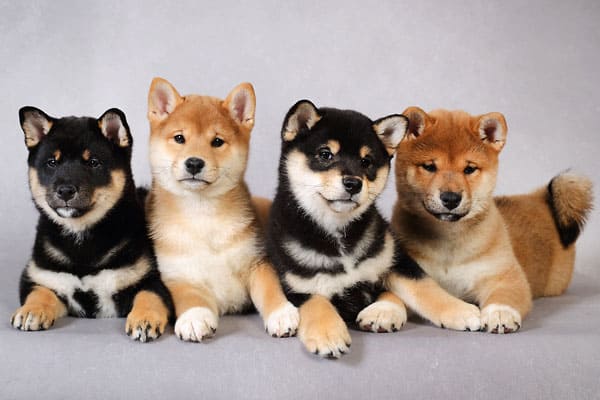
Prospective Shiba Inu Puppy Parents: Understanding OFA Tests
If you are planning to be a new Shiba Inu parent - congratulations! And much appreciation for seeking information on OFA testing. You are on a path to being an awesome and responsible pet parent.
Ideally, both parents of Shiba Inu puppies should be CHIC certified.
This ensures that the breeder has made an effort to test for the most common diseases that affect Shiba Inus.
To be CHIC certified, breeders must test each dog for:
- Hip dysplasia
- Patellar luxation
- Eyes
It’s important to remember that being CHIC certified DOES NOT mean that the Shiba Inu passed OFA tests.
It just means that the Shiba Inus has taken all required tests AND the breeder has allowed the tests to be available to the public domain.
This is why it’s important to understand how to understand OFA grading scores discussed earlier in the article.
If you are purchasing a Shiba Inu puppy as a family pet and not for showing or breeding, you’ll want at a minimum:
- Both parents CHIC certified with passing scores with possible exceptions for “borderline” test results
If you are planning to show or breed Shiba Inus, you’ll want better results and more tests done such as:
- Both parents CHIC certified with passing scores on each test.
- DNA tested for Gangliosidosis (type 1) long-haired gene, cream coat gene.
- Canine genetic diversity tests
How To Read OFA Numbers
Understanding the long string of OFA letters and numbers may look complex, but actually is straightforward once you understand the codes.
Here’s a typical example of an OFA number assigned to a Shiba Inu for an hip dysplasia test.
SHU-3195E26F-VPI
“SHU” - Breed code = Shiba Inu
“3195” - Means the 3195th Shiba Inu to pass this particular test
“E” - Rating designation = excellent
“26F” - Age in months and sex of dog = 26-month-old female
“VPI” = Indicates that the dog is permanently identified (PI) AND verified by an attending veterinarian (V) so VPI
Other codes you may come across include:
- P = physical restraint used so above code would like this: SHU-3195E26F/P-VPI
- C = Chemical restraint used so above code would look like this: SHU-3195E26F/C-VPI
- U = Unknown restraint used so above code would look like this: SHU-3195E26F/U-VPI
- PI = Permanently Identified so, SHU-3195E26F-PI
- NOPI = Not permanently identified so, SHU-3195E26F-NOPI
- Phenotype grading = E, excellent, G, good, F, fair, borderline, mild, moderate, severe (Only excellent, good, and fair are awarded OFA numbers)
- GDC = Before OFA, the GDC or genetic disease control kept similar dog health records. In 2002, GDC merged with OFA. OFA numbers beginning with GDC indicate testing was done by the GDC
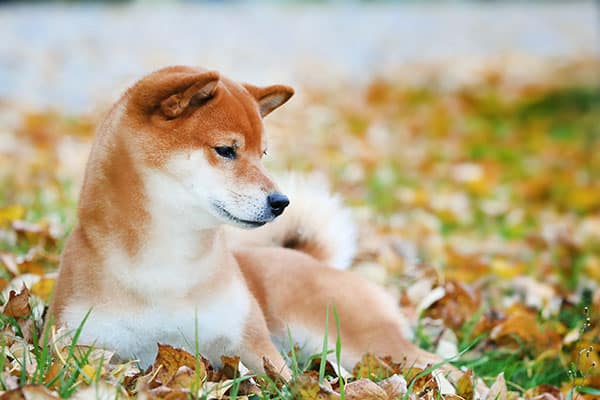
Wrapping It Up
Whether you're planning on bringing a Shiba Inu puppy home, or thinking about breed preservation - OFA tests are an indispensible tool to help you ensure your pups are healthy.
The value and peace of mind that these testings provide is more than worth the additional costs and time it takes.
In conjuction with other health screenings, OFA tests, as well as D.N.A. tests can ensure the future of the Shiba Inu is bright, healthy, and active!

Thanks for visiting Myfirstshiba.com! We do our very best in providing our readers with awesome content about our beloved Shiba Inu breed. Some of our articles include reviews and recommendations to our favorite products. We do occasionally earn commissions from certain affiliate links that help support our work and mission. Thanks again for visiting. Shiba Kisses To All!
